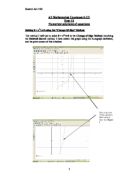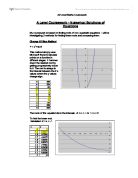x1 = -1.5
x2 = -1.295 (I substituted x1 = -1.5 into the iterative formula to get the value for x2)
x3 = -1.227690 (I substituted x2 = -1.295 into the iterative formula to get x3)
x4 = -1.220812
x5 = -1.220744
x6 = -1.220744085
x7 = -1.220744085
I can see some convergence from x5. There has been no change in the x-values between x6 and x7 for this number of decimal places. I know that this method for finding the root has worked.
My negative root is x = -1.220744 (6 decimal places)
Now I will find the positive root of this function. The starting value (x1) is approximately 1.5 when f(x)=0.
x1 = 1.5
x2 = 1.116379
x3 = 0.862068
x4 = 0.745761
x5 = 0.725049
x6 = 0.724492
x7 = 0.724491959
x8 = 0.724491959
I can see some convergence from x6. There has been no change in x-values between x7 and x8 for this number of decimal places. It is clear that another root has been successfully found using this method.
My positive root is x = 0.724491959 (9 decimal places)
The error bound is: 0.0000000005
However, the Newton-Raphson method would not work with the graph below:
If I start from the turning point of the curve, I do not think it will converge (see Figure 4). The equation for this function is 0 = x4+2x3+3x-4 f’(x) = 4x3+6x2+3
The iterative formula is: xn+1 = xn- f(xn)
f’(xn)
So the iterative formula for this equation is: xn+1 = xn- xn4+2xn3+3xn-4
4xn3+6xn2+3
On my diagram of this function, I have taken my x1 value to be about –1.6
x1 = -1.6
x2 = 3.682591
x3 = 2.658976
x4 = 1.899865
x5 = 1.353797
x6 = 1.003365
x7 = 0.847116
x8 = 0.819172
x9 = 0.818390
x10 = 0.818389
x11 = 0.818389
From that, I can quite clearly see that there is a convergence beginning to show towards the positive root. However, my aim was to find the negative root, and I could not find it. Therefore, the Newton-Raphson method has failed to find that particular root, even though the starting value was close to it.
Another example where the Newton-Raphson would not work is the function (x+21/2)1/2 ln (x+21/2) = 0. The graph and calculations of this is below:
The function is: (x+21/2)1/2 ln (x+21/2) = 0
f’(x) = ((x+21/2)1/2 X 1 ) + (ln (x+21/2) X ½ (x+21/2) -1/2)
x + 2 1/2
(x+21/2)1/2 + ln (x+21/2) (x+21/2) -1/2
(x+21/2)1 2
1 + ln(x+21/2)
(x+21/2)1/2 2(x+21/2) 1/2
= 2+ ln((x+21/2)
2(x+21/2) 1/2
The iterative formula for the Newton-Raphson method is:
xn+1 = xn = f’(xn)
f’(xn)
x n+1 = xn - 2(x+21/2)ln(x+21/2)
2 + ln(x+21/2)
I choose my starting value of x (x1) to be about –1.3.
x1 = -1.3
x2 = -4.22079
x3 = not defined
x4 =
Another example where the Newton-Raphson method would fail is with the function x3-5x+0.1=0. The graph of this, along with the calculations is shown below:
f(x) = x3-5x+0.1 f’(x) = 3x2-5
The iterative formula for the Newton-Raphson method is: xn+1 = xn- f(xn)
f’(xn)
My iterative formula is: xn+1 = xn- x3-5x+0.1
3x2-5
I will take my starting value of x (x1) to be 1.1.
x1 = 1.1
x2 = -1.870073
x3 = -2.400053
x4 = -2.259618
I can see that there is no convergence to the positive root I am looking for. Therefore, the Newton-Raphson method has failed to find that particular root despite taking a starting value close to it. This is shown graphically in Figure 6b.
Solving 0= x5+4x2-2 using the “Rearranging method”
The graph of this is shown below (or see Figure 5):
I will rearrange f(x)=0 in the form of x = g(x). As my equation is 0= x5+4x2-2, there are possible rearrangements of this. I will only pick out two possible rearrangements.
Rearrangement 1: 0= x5+4x2-2
-x5= 4x2-2
x5= -4x2+2
x= (-4x2+2)1/5
On the Autograph software, I will draw the equation y= g(x)= (-4x2+2)1/5 and the line y = x. This is shown below (or see Figure 6):
Rearrangement 2: 0= x5+4x2-2
-4x2= x5-2
4x2= -x5+2
x2= (-x5+2)/4
x= ((-x5+2)/4))1/2
On Autograph software, I will draw the equation y = g(x) = ((-x5+2)/4))1/2 and the line y = x. This is what it looks like below (or see Figure 7):
I can see from the diagram directly above for Rearrangement 2 that g’(x) is between 1 and –1, so there should be a convergence.
Therefore, my chosen rearrangement is Rearrangement 2, which is: x = ((-x5+2)/4))1/2
So my iterative formula for this rearrangement is: xn+1= ((-xn5+2)/4))1/2
I can see from my graph above that the point of intersections of the two lines is between x = 0 and x = 1. So my starting value for x (x1) would be 0.5.
x1 = 0.5 (I substitute x1 = 0.5 into iterative formula to get x2)
x2 = 0.701561 (I substitute x2 value into iterative formula to get x3)
x3 = 0.676396
x4 = 0.681619
x5 = 0.680600
x6 = 0.680802
x7= 0.680762
x8 = 0.6807698
x9 = 0.6807683
x10 = 0.6807686
x11 = 0.6807685
x12 = 0.6807685
I can see a convergence from x8, and there is no change between x11 and x12 for this number of decimal places. I know that this method has worked successfully to find a root. This is shown graphically in Figure 7.
My root is: x = 0.68077 (5 decimal places).
I know that using Rearrangement 2 helped me find a root of 0=x5+4x2–2. However, Rearrangement 1 of this function would not have helped me find the same root. This is explained with a diagram of Rearrangement 1 and its iterative formula below. This failure is shown graphically in Figure 6:
Rearrangement 1: 0= x5+4x2-2
-x5= 4x2-2
x5= -4x2+2
x= (-4x2+2)1/5
The iterative formula is: xn+1= (-4xn2+2)1/5
From the graph above and from Figures 6 I can see that the point of intersection between y = x and y = g(x) = (-4x2+2)1/5 is between x = 0 and x = 1. Like before, I will take my starting value of x (x1) to be 0.5. The same process of substituting values of x into the iterative formula, as in the last Rearrangement is carried out here.
x1 = 0.5
x2 = 1
x3 = -1.148698
x4 = -1.268010
x5 = -1.346816
I can immediately see that there is no convergence in this rearrangement towards the particular root I am looking for, that I found in the previous rearrangement (Rearrangement 2). Therefore, I have found a rearrangement of the same equation (Rearrangement 1) where the iteration has failed to converge to the required root.
Comparison of methods
I will now use the equation 0=x5+4x2-2 that I solved using the Rearrangement method and see if I can find the same root using the other two methods- the Decimal Search method and the Newton-Raphson method. I will start off with the Decimal Search method.
From the graph 0=x5+4x2-2, I can see that the root lies between x = 0.5 and x = 1
I can see that the change of sign is between x = 0.6 and x = 0.7.
The change of sign is between x = 0.68 and x = 0.69
The change of sign is between x = 0.680 and x = 0.681
The change of sign is between x = 0.6807 and x = 0.6808
I can see that the change of sign is between x = 0.68076 and x = 0.68077
As there is a change of sign, I can finally say that the root of this function is in the interval [0.68076, 0.68077]. Therefore, using this method, I can take the root of this equation to be x = 0.680765, which is similar to the answer I got when finding the same root using the “Rearrangement method”.
I will now use the Newton-Raphson method to find the same root for this function.
0=x5+4x2-2 f’(x) = 5x4+8x
The iterative formula for the Newton-Raphson method is: xn+1=xn- f(xn)
f’(xn)
So my iterative formula is: xn+1=xn- xn5+4xn2-2
5xn4+8xn
I think that a good starting value for x1 would be 1.2
x1 = 1.2
x2 = 0.887083
x3 = 0.720596
x4 = 0.682450
x5 = 0.680772
x6 = 0.680769
x7 = 0.680769
I can see a definite convergence from x6. So the root is x = 0.680769 which is similar to what I obtained when finding the same root using the Rearrangement method and the Decimal Search method.
I have now found the same root using the Decimal Search method, the Rearrangement method and the Newton-Raphson method. It is now possible to compare these three methods in terms of ease and the speed of convergence.
I found that the Decimal Search method was the simplest out of the three, as it does not involve any iterations, so mistakes with iterative formulas and rearrangements are not applicable as with the other two methods used. This method is very advantageous because it immediately provides intervals for the root which I can work towards to obtain an answer, and with each interval, I can work out what the error bounds are straight away. As there are no complicated iterations involved, this method is very easy to use on the calculator and mistakes on the calculator are far less likely to occur than for the other two methods (the Newton-Raphson method and the Rearrangement method). However, this was a very time-consuming method to do on a calculator. Although I only used a calculator for this coursework, it would have been quicker and more efficient if I had used Excel for the Decimal Search method.
Both the Newton-Raphson method and the Rearrangement method were fixed point estimates and involved an iterative process. Therefore, these methods were very similar. However, these two methods differ because there is a specific formula for the Newton-Raphson method. Although the Newton-Raphson method was more complicated than the Rearrangement method, it gave a much more rapid rate of convergence. In fact, the Newton-Raphson method gave the most rapid rate of convergence to 6 decimal places, whereas, for the Decimal Search method, it took me very many calculations to converge to 5 decimal places. So, the Decimal Search method gave the slowest rate of convergence. These two methods were not as time-consuming as the Decimal Search method because it did not involve having to find a change of sign in many particular intervals; there was already a convergence towards the particular root I wanted. However, it was really easy to make mistakes on the calculator due the order of the terms in the iterative formulae.
I used the Autograph software to draw these graphs. This was so much quicker than drawing the graphs by hand, and Excel does not have the facilities to draw such advanced graphs. The Autograph software was very easy to use and it also helped me to find out which rearrangement of a function were suitable (when carrying out the Rearrangement method) and in which interval the root was in (when using the Decimal Search method).








